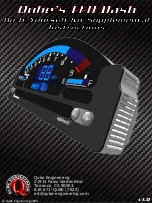
Dew Point Sensors
–
Mini
User Manual v1.1
www.compressedairalliance.com
5
About Dew Point Sensors
When it comes to monitoring
compressed air and gas systems,
nothing offers a better payback than
a dew point sensor. Once you have
moisture in your system, everything
becomes a problem. If you have ever
had this occur, you'll know the
problem occurred days before you
discovered it and it took even longer
to dry out after the issue was fixed.
Most people don't think of dew point
sensors as providing efficiency, but
wet compressed air or gases will do
irreparable damage to components,
create reliability issues throughout
your entire plant and allow bacteria,
rust and corrosion to build up in your
system. Moisture issues are
extremely difficult to rectify and
component failures will go on for
years.
If you have a system running a
desiccant dryer or with a specified
purity requirement, then you are
already aware that dew point is a
critical component of your system
and therefore should be monitored
continuously.
Indicators on refrigerant dryers
don’t measure dew point
The indicator on your refrigerant
dryer is exactly that, an indicator, it is
not measuring the dew point
entering your plant. It is only
measuring the temperature of the
refrigerant gas. Any number of issues
before and after your dryer can lead
to the dew point deteriorating and
will not be shown on the dryer
indicator.
Compared to your compressed air or
gas system, dew point sensors are
cheap, easy to install and have low
maintenance requirements. They are
the most cost effective sensor
purchase you are ever likely to make.
Benefits of monitoring dew point
•
Improve system reliability
•
Reduce product contamination
risks
•
Reduce system maintenance
•
Reduce operating and energy
costs
•
Reduce the risk of rust and
corrosion build up
•
Improve dryer reliability
•
Improve filter life and
performance
•
Reduce the risk of bacteria,
fungus and yeast build up
•
Alerts you to changes in dryer
performance before moisture
appears in your plant
•
Easy to install and low
maintenance
•
Suitable for temporary or
permanent installations.






































